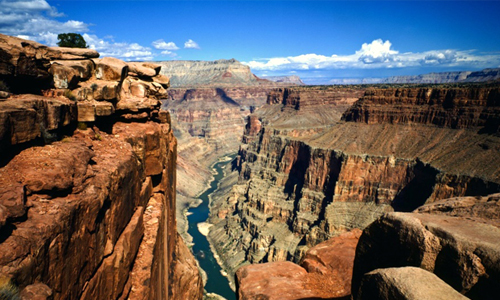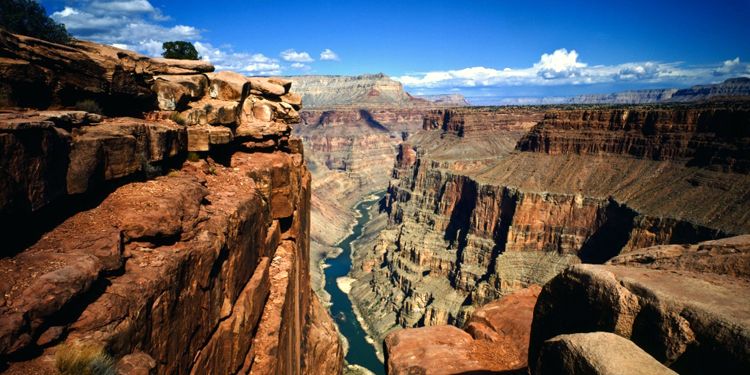

Do Charles and David Koch want to mine the Grand Canyon for uranium?
A “dark money” organization tied to the billionaire Koch brothers is allegedly aiding Arizona politicians’ and special-interest groups’ efforts to block a bill that would ban uranium mining around Arizona’s iconic landmark, The Phoenix New Times reports.
According to the Grand Canyon Trust, here’s what Grand Canyon National Heritage Monument Act would do:
- Protects 1.7 million acres of tribal homeland around the Grand Canyon, including water sources and sacred sites
- Bans new uranium mining claims (making the current 20-year ban permanent)
- Still allows hunting, grazing, recreation and other uses to continue under existing law
The proposal, in so many words, deems the area around the Grand Canyon a national monument. The bill is supported by 80 percent of Arizonans as well as a number of environmental organizations and native tribes.
However, pro-mining Arizona Chamber of Commerce and the Koch-linked Prosper Foundation have co-authored a report calling the efforts a “monumental mistake” and that monument designation for the Grand Canyon “will only hurt—not help—Arizona.”
The proposed Grand Canyon Watershed National Monument is a monumental mistake. Read more: https://t.co/iyQ4aLm0NI pic.twitter.com/5iegWjaock
— Prosper (@ProsperOrg) April 15, 2016
As it appears, the Prosper Foundation receives nearly its entire budget with funds from the Koch-backed American Encore, according to 990 tax forms seen by Greg Zimmerman, the policy director at the Center for Western Priorities.
As Zimmerman explained on ThinkProgress:
Prosper, which was formed in 2013, covers nearly its entire budget with funds from Koch-backed American Encore—formerly known as the Center to Protect Patient Rights. According to tax filings, American Encore has funded 83 percent of Prosper Inc.’s total budget since its creation, donating over $1.5 million to the organization in 2013 and 2014.
Despite vast public support for permanent protection of the area, Zimmerman pointed out that “most of Arizona’s congressional delegation—including Senators John McCain and Jeff Flake, and Representatives Paul Gosar, David Schweikert, Trent Franks and Matt Salmon—want the gateway to the Grand Canyon open to uranium mining.”
The state of Arizona has mined for uranium—the raw material needed to make nuclear power—since the early 1900s. Though it has created an industry for the state, the process “has caused cancer in miners who breathed it or the many Native Americans who drank it after their water became contaminated by it,” Arizona’s 12 News noted.
Still, Republican lawmakers have long been opposed to conservationists’ efforts to protect the Grand Canyon from the uranium mining. McCain and Gossar proposed legislation Oct. 12, 2011 to open 1 million acres of public lands that form Grand Canyon National Park’s watershed to new uranium mining. The bill would have overturned an existing moratorium on new mining and mining claims and block Interior Sec. Ken Salazar’s proposal to extend those protections for the next 20 years.
In November, Gosar issued a scathing statement against the current Grand Canyon National Heritage Monument proposal that was introduced by U.S. Rep. Raul Grijalva, D-Ariz.:
“Rep. Grijlava’s bill, pandering to extremist environmental groups, will kill jobs, stifle development, permanently prevent mining and future grazing leases, impose significant OHV road closures and significantly restrict hunting, timber harvesting and commercial recreational activities on 1.7 million acres in northern Arizona. I encourage the southern Arizona Congressman to focus on killing jobs and locking up millions of acres of land in his own district.”
https://twitter.com/azcpolitics/status/662676722769403904 is overwhelmingly popular across Arizona, and yet the political establishment in the state is so diabolically opposed to it,” he told The Phoenix New Times.
“There is a tight-knit community among right-wing Republican leaders who are strongly opposed to public-land protection,” Zimmerman said, adding “what these guys do to move money is incredibly sophisticated.”
YOU MIGHT ALSO LIKE
San Francisco Becomes First Major City to Require Solar Panels on New Buildings
Celebrating John Muir’s Incessant Study That Saved Yosemite National Park
Bill Nye vs. Sarah Palin on Climate Change: Who Do You Believe?

 233k
233k  41k
41k  Subscribe
Subscribe 
